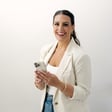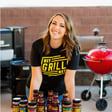Become a Creator today!Start creating today - Share your story with the world!
Start for free
00:00:00
00:00:01

Episode 121: Tips for Creating an Engaged Email List
Copyrighter Jess Jordana is back on the podcast to chat about email marketing. We're covering email platforms, the kinds of emails that people should be sending to their list, and tips for writing engaging emails. If you aren't familiar with Jess you want to go back to episodes 42 and 66 for some more great content and to learn more about Jess trust me your website will thank you for it.
For show notes visit...https://daveyandkrista.com/btb-episode-121-jess-jordana/
Transcript
Leveraging Old Content
00:00:05
Speaker
You can take a piece of content and either tell a story about how it came about or go a little bit deeper with it or explain something that has changed in your mind about it or how somebody used it or whatever. And you can really utilize a lot of the content that you've made for years in your business before and that can kind of get your juices flowing on what to use in people as well.
Introduction to Brands at Book Show with Jess Jordana
00:00:33
Speaker
Welcome to the Brands at Book Show, where we help creative, service-based businesses build their brands and find more clients. I'm your host, Davy Jones.
00:00:44
Speaker
Copywriter Jess Jordana is back on the podcast to chat about email marketing. We're covering email platforms, the kinds of emails that people should be sending to their list, and tips for writing engaging emails. If you aren't familiar with Jess, you'll want to go back to episodes 42 and 66 for some more great content and to learn more about Jess. Trust me, your website will thank you for it.
00:01:06
Speaker
Be sure to check out the show notes at DaveyandChrista.com for the resource prevention during the episode. And we want to hear from you. Let us know what kind of content you'd like to see on the Brands at Book podcast as we move forward. To leave your feedback, just send us a DM on Instagram, at DaveyandChrista. Now, onto the episode.
Building and Using Mailing Lists Effectively
00:01:28
Speaker
All right. I am back. Another episode of the Brands at Book Podcast with copywriter extraordinaire, Jessica Jordana. Welcome back to the podcast. Thanks. Thank you so much for having me back. I'm excited to chat today.
00:01:40
Speaker
Yeah, always some of my favorite conversations, both on the podcast, off the podcast, but you're always full of great practical advice. And today we're talking about actually we're recording a marathon of episodes here. So we're recording two episodes, but we're starting with mailing lists. We're talking about building mailing lists, re-engaging a mailing list. I think something that we were just talking about is, you know, people follow the advice of building a mailing list and then they don't mail their mailing list.
00:02:06
Speaker
which is an issue. And it's not always as easy as just deciding one day, oh, well, I'm going to send an email. I mean, it is that easy on one hand, but certain things to think through for sure. So if you have been thinking about starting a mailing list, if you have started a mailing list, you're not quite sure where to go with it. I think this episode is for you. But I'm going to kick it to you, Jess, and why just for somebody who has no reason to believe that they should meddle in such things, why should someone start a mailing list?
00:02:36
Speaker
Yeah, I think that's a great question and I think that it can be really intimidating. It doesn't have to be intimidating and we'll talk more about that today. But I also don't think that necessarily everybody should start an email list and I think that the way
00:02:52
Speaker
You can kind of tell whether you should or not as if you plan to actually do something with it. So it's really hard. We're going to talk about this later to start gathering emails with really no intent and then later engage them into something that you want them to do.
00:03:09
Speaker
versus if you start out your email list with something free to give them a place that you're for sure going to send them or content that you're going to send them consistently. It's a lot easier to keep somebody engaged than it is to get them engaged once they've gotten cold in the past. So
00:03:29
Speaker
I think intent is the biggest thing just because people say you should be gathering emails. If you don't have the bandwidth for that or you don't have a plan for it or you're not ready for that, then I wouldn't just start gathering emails for no reason.
00:03:42
Speaker
I do think too just off of that, I mean, and there might be situations in which maybe an email list isn't something that's part of your growth plan. I mean, Chris and I back when we were shooting weddings, we only at max we would take, I think our biggest year was like 45 weddings and that was way too much. And so, we scaled it back to only wanting to shoot the 20-ish weddings a year that we really wanted to shoot.
00:04:07
Speaker
I think lead generation when you're only taking on 20 people at a time or 20 people in a given year looks very different for us now who we sell digital products and so there's more scale. And that's not to say that you should only be building a mailing list if you're selling digital products. Certainly service-based businesses can benefit from a mailing list as well. But I think that's an important point that maybe it's just not in the cards for you to build one.
00:04:34
Speaker
Yeah. Yeah.
Email List Engagement Strategies
00:04:35
Speaker
I think on the flip side, it can be really valuable in order to build trust really quickly and build a deeper level of trust with people just because you have a direct line to somebody to send them value weekly, monthly, whatever you decide to do. And I think that if you have that in mind,
00:04:58
Speaker
it's easier to stay top of mind on when you're in somebody's email inbox than it is necessarily for something like social media or whatever because
00:05:08
Speaker
It's a lot harder to control the deliverable. You can't control the deliverability of social media, but you can hopefully improve your deliverability for email and things like that so that people are actually at least seeing your name in their inbox, whether they're opening it or not. I know Graham Cochran on his podcast a couple of weeks ago was talking about how your open rate isn't really everything because
00:05:33
Speaker
your open rate indicates how many people are opening that per week, but different people are involved in that percentage. And so you're really reaching more people than you probably would think that you are. And you're staying top of mind because people say, oh, Jess sent an email today. Maybe I'll read that in a couple of days or something like that. So I think it has a lot of potential to one, when people read it,
00:06:01
Speaker
build deeper trust and to keep you top of mind in a more controllable way. Yeah, I think that's an interesting point too about just the impressions that you're making through an email showing up in an inbox. And you have to imagine that for most people, maybe not everybody, but my inbox does feel pretty cluttered at times. But for the most part, probably less competition in an inbox versus in somebody's social media feed.
00:06:26
Speaker
So there's that. Also, for people who don't understand the terms that we're talking about, when I say impression, it would just be somebody who sees your name, like even in Google, for instance, if your website were to show up for a search but someone doesn't click on it, you still had the impression. And then Jess was talking about open rates and click rates, open rates being the percentage of people who open your email, of course, and then click rates being the percentage of people who click on a link
00:06:53
Speaker
in an email of those subset of people who open it. Yeah. And overall, when we talk about engagement with emails, we're talking about how many people are opening, how many people are taking action. Those are kind of your metrics that you want to look at in terms of engagement. Yeah, absolutely.
Getting Started with Email Marketing
00:07:11
Speaker
So, as far as where should we start in terms of building a mailing list? What does that entail?
00:07:17
Speaker
Like in terms of what do you need in your hands to build it? Yep, like what tools should we start with in order to build a mailing list? If you're telling somebody that they should build a mailing list today, where would you direct them?
00:07:29
Speaker
Yeah, I feel like the tools question is maybe a better question for you, but just on a very basic level, you need an email marketing system of some kind. So whether that is convert kit, active campaign, flow desk. I know a lot of people use MailChimp when they're starting out. I use Cartra, which is my course platform. So whatever you're going to use to send out emails, you need that.
00:07:54
Speaker
And then I would say you also need, this is not a tool, but it's an asset. You need something free to deliver people. So I'm not a huge fan of the forum on your website that just says, join the mailing list or join the fam or whatever it may be because people don't really have intent whenever they're joining that maybe their intent is like, Oh yeah, this sounds fun.
00:08:17
Speaker
But they're not like, oh, I want that thing in order to get that result. And that higher intent is going to lead to higher engagement in the future. So if you have something free that people want, then that is going to serve you really well. And I would not, I think a lot of times people overthink the free thing. You can start.
00:08:38
Speaker
with a minimally viable product and change it later. I've had so many different freebies that I've changed out in my business. And it's better to just start and see what people want than it is to wait forever for the perfect freebie idea to come down like lightning in your brain. So email marketing platform and possibly a website. Sometimes you can host a landing page using your email marketing platform.
00:09:07
Speaker
But I think you would also recommend hosting that on your website so that you're gaining traffic and sending people to your website and all of that kind of stuff. So you need some sort of page to house that form for people to sign up.
00:09:20
Speaker
Yeah, that's a good point though. If you don't have a website yet, there's no reason to not start collecting emails because like you said, most email marketing platforms are going to have some sort of landing page builder built in. So that shouldn't hold you up. And then even if you have a website, but you don't feel like it's something that you can update for some reason or another, again, use the landing page builder that comes with your email platform. It doesn't necessarily have to be pretty. I think that to a certain extent,
00:09:48
Speaker
as long as you do a good job with the copy, then you can make it compelling enough for somebody to fill out. As far as email marketing tools go, you use Cartra, which makes sense too because it's tied to everything else that you're doing, your cart and whatnot. For people who are just getting started, it used to be everybody went to MailChimp like you said because they have a free plan. ConvertKit has a free plan now too. Oh really?
00:10:11
Speaker
Yeah, I think that's a much better place to start because it's going to give you more opportunity to grow into something that you'll probably use in the future. Yeah, I think people who start out using MailChimp adopt some habits that are like kind of janky rigging things to work. And then if you're ever going to switch, which if you're going to grow, you will switch from MailChimp, then it's really hard to
00:10:35
Speaker
like switch everything over if you have all of these workarounds. So just starting with something like Flowdesk or like ConvertKit that you're gonna grow with a little bit more might be a better option than trying to just start with something free that won't be able to scale.
00:10:53
Speaker
Yeah, and it's always harder switching platforms. And I think that's true across the board, whether it's cart, email, you know, whatever. So I agree, ConvertKit is a great place to start. And it has a lot of those tools like landing page builders that we were just chatting about.
00:11:08
Speaker
So those are the tools, those are the places to start. You've touched on a few different things, one of them being a freebie. One of the things that I liked about what you said was just make something, see how people respond to it. I think even within that, there's a lot of room to iterate. So for instance, you make something, people aren't downloading it for whatever reason, you don't necessarily have to make something completely new. Like if you still believe in the idea, it might be as simple as changing the title. People don't necessarily know that the guide didn't change and it doesn't matter because they didn't download it anyways.
00:11:38
Speaker
So, there's all sorts of little steps you can take along the way before actually putting the effort of creating something totally and completely new.
Aligning Freebies with Offers
00:11:45
Speaker
What other tips though do you have for building a freebie and just what should go into that? Yeah, I think the changing a title thing, there's a lot of tips that I could give in there. I think the biggest one is
00:11:58
Speaker
A lot of times people go the simple route, which I'm all for simple, but saying like photography checklist or some, or like wedding checklist. And you can do a simple switch of that title by just explaining the outcome that they're going to get from that. So maybe like the confident photographer checklist or.
00:12:19
Speaker
the seamless wedding day checklist, even just adding that little word shows them what they're gonna get out of it, which is gonna make more people say, oh, I want that thing because I want that outcome. So I think that's a really simple way to iterate that. I think in terms of building a freebie too, it's necessary to think of not only what is your expertise, but what is your offer? So I could right now,
00:12:47
Speaker
probably give a freebie that's all about emails. But if I don't have an offer for my digital products for emails, then it's not going to serve me super well to give out that freebie because that's not going to lead directly to my offer. So instead, I give a freebie that is more geared toward your actual website because I have resources for your website copy.
00:13:12
Speaker
I think just making sure that those things align is really important so that you're not like getting a bunch of people that are downloading because they want one thing, but then you don't have a paid thing to lead them to from that.
00:13:26
Speaker
Yeah, for sure. I think a few things that you talked about in there too like outcome especially and how important that is and to actually give people hopefully a quick win within the freebie that you're offering. I think there's nothing worse than people getting in there and realizing, you know, maybe A, there's no value at all or two, getting in there and then being more confused then, you know, before having downloaded it or consumed it, you know, whatever media you're using.
00:13:50
Speaker
And when you can offer people even a quick win or a small positive outcome, then I think they're more likely to invest in something like your main offer. Yeah. And I think, too, it's easy as...
00:14:05
Speaker
overachievers, which most business owners are overachievers to a certain extent, we want to overdeliver with the freebie, which I totally believe in giving more value than you promise for sure. But at the same time, you don't want people to get stuck on your freebie. So you don't want to give them so much to where they could spend
00:14:26
Speaker
three months. And I've done this before with a webinar. I've given way too much in the webinar where people are doing homework for months and they're like, oh, I'm good on this. And they don't need what I actually have to offer versus giving them a little taste. And like you said, a quick win that is then going to lead them to, okay, I want more of that kind of quick sort of thing.
00:14:47
Speaker
I think that's important. You're not under serving people by giving them a quick win. You're actually serving them better because you're showing them what's possible with what you actually offer. Yeah. And depending on what you're doing too, maybe it is something that would take them three, six months to do on their own. But as long as you can paint the picture that, hey, or you could invest in a service that's going to get this done for you in a week, that's a critical piece to also portray just so that people understand like, okay,
00:15:17
Speaker
Yeah, I mean, this is great in that she's telling me exactly what I need to do for my website copy or I could just hire to do it and it's going to be done within a couple months and it's going to be a much easier process and I'm probably going to be happier with the outcome. Yeah, for sure. Yeah.
Nurture Sequences: Building Relationships with Subscribers
00:15:32
Speaker
We have email platforms. Somebody signed up for something like ConvertKit or Flowdesk. From there, they're creating a freebie. They have, let's say, a guide or a free training that they're going to deliver once people put their name and email in the form. Just to recap, that form goes on your website or you can use the landing page builder in the email platform that you choose. From there, what should happen?
00:15:56
Speaker
Yeah. So from there, you want to have an email sequence that is going to come after you deliver your freebie. I call this a nurture sequence just because that is what you should be doing. A lot of people call it a welcome sequence, but I find that that language makes you feel like it's more like welcome to me instead of like nurturing them toward what you want them to go to.
00:16:22
Speaker
And so I actually have a blog post from I think it's on the rising tide website that we can drop in the show notes that talks through what an automated nurture sequence should look like. So we can drop that for people in there just to give them a little bit more information. But really it should start out by
00:16:41
Speaker
helping them realize what results they can get with that freebie, helping them really consume that well and follow through on it. And then introducing yourself a little bit with them in mind, like how can you help them do what they want to do? And then showing them what's possible in whatever else you have. So leading them either to more education or leading them down a path to your offer or whatever that may be.
00:17:08
Speaker
And then at the very end, I like to tell people what to expect from my email list in general. So now you've received these emails for five or six days. And now you're going to get a weekly email from me that is talking about X, Y and Z typically, just to set the expectation of
00:17:29
Speaker
what is going to come into their inbox regularly so that they know what to look forward to and so that they'll want to open those emails. And if they don't want that value, they can unsubscribe. So just inviting them to do those two things so that you have those qualified people on your larger list after that nurture sequence.
00:17:51
Speaker
Yeah, that's a good point and I like the distinction too between the nurture sequence and the welcome sequence. Two, I also think that we have people download some of our guides and things like that who have been around for years and so what they need is more of a nurture sequence and less of a
00:18:08
Speaker
hey welcome and this is who we are and what we do and stuff. Of course we segment our list appropriately but I think kind of the outline that you just mentioned is very straightforward. Not simple necessarily but very straightforward. As far as emails go though, so we have our nurture sequence and this is what we're using to nurture people and hopefully bring them closer to our offer, bring them up potentially the value ladder.
00:18:32
Speaker
indoctrinate them you know beyond that though I think where people get hung up a little bit is okay what do I send on let's say a weekly basis or you know I guess a secondary question there too would be and we suggested that we talk about this at the beginning of the interview if you haven't sent an email for months you know or even years and you've been building this email list what do you do?
Engaging Content and Email Formats
00:18:54
Speaker
Yeah, I'm picturing like all these names in the cloud with like cobwebs collecting on them. And that is totally normal. Like I think that happens to so many business owners. So I would not beat yourself up about that. I think there are ways to
00:19:09
Speaker
move forward from that and you don't have to start from scratch necessarily. But I think in terms of the weekly email, I always start with what emails do I like to open? So what emails really get my attention and feel make me feel like I'm getting value from them even if I don't like apply something immediately or whatever. I think we overthink the word value a lot of times and sometimes value can be
00:19:36
Speaker
I have this tangible thing that I can do and apply to my business now, but sometimes value can be hearing a story that you can relate to or being able to interact with somebody and reply to them or whatever, or just learning something new. So for me, I like to open emails that
00:19:55
Speaker
teach me something. I'm a really big input person and so I read a lot. I listen to a lot of podcasts and I need to disseminate that information in order to really digest it myself. So I process what I'm learning with my email list. I share with them
00:20:14
Speaker
And it's always relevant to copywriting or business or whatever, but I share with them what I'm learning and how I'm applying it. And I suggest a way that they can apply it too. So my weekly emails are not like.
00:20:29
Speaker
super themy or anything like that. It's really just like a conversation where I show up consistently with those people and that really a lot of people have told me, which is the best compliment you can get if you're sending emails that they're the emails that they like wait for each week in order to open and things like that. So even though it's simple, it connects with people, it teaches them something and it keeps me top of mind.
00:20:56
Speaker
I think if you want to do something a little bit more structured, I find that it's a lot easier to write if you give yourself constraints. So an example of this is James Clear. He has a really great newsletter that's weekly and it's the 321 newsletter. He sends out three thoughts of his own, like one, two, three bullet points, two quotes from other people.
00:21:22
Speaker
and then one question for you to ponder. He doesn't expand on any of it. He just like plops it in the email and lets you, lets your mind take it wherever you need it. And it's so consistent, but I can imagine it's also a lot easier for him to write because he could write a million things to his email list. He's the habits guy if you don't know who he is, but he could write so many things, but he,
00:21:49
Speaker
has a defined constraint that he meets every single week. So similarly, my friend Jenna does a FICA Friday. And FICA is a Swedish word that means making time and slowing down to share a cup of coffee with friends. So the stuff that she shares
00:22:08
Speaker
is it's about making time because she's like a productivity kind of person. It's about slowing down, like she'll share a recipe or something like that. But it's also the, like she's physically making time and slowing down to meet with her email list kind of thing. So that gives her a little bit of creative restraint, constraint in order to be able to deliver something consistently. Whereas if you just say, okay, I need to write an email this week, you sit down and you're like,
00:22:38
Speaker
I have no idea what to write. So coming up with something like that that is going to help you show up each week that you're excited about might be really helpful.
00:22:48
Speaker
Yeah, for sure. And I'm thinking through some of my favorites and I think like you, I like stuff that's practical or makes me think, you know, but I think even the – there's not a single type. I mean, I guess similar to the examples that you just gave, they don't all look the same. I think people are very much, you know, they have their own style and I think when they're kind of true to maybe their strengths too, that's helpful. I mean, Seth Godin's one I read almost every day and it's going to be short but I'm going to
00:23:12
Speaker
think about it. Often throughout the day, there's another newsletter I get that it's honestly like two sentences and it's typically like basically pushing you to a blog post. But even if I don't click into the blog post every day, I'm usually interested in kind of what they're writing about and sharing. So I'll open it and on the days that I click into the blog post, I can look into the blog post.
00:23:35
Speaker
Yeah, that's another thing that I forgot to mention. I would highly recommend repurposing content and I know you guys do this in your weekly email or monthly. I'm not saying you have to send it weekly if you don't want to, but we have so much content as business owners and I think we adopt this mindset that like
00:23:56
Speaker
Once we put it out there, it's kind of done and everybody in our like stratosphere has seen it, which that's just not true. And so because I have like educational sort of Instagram posts and things like that, I repurpose that actually to my email list.
00:24:12
Speaker
And they have multiple times thanked me because they're not on Instagram or they didn't see it on Instagram or whatever.
Repurposing Content Across Platforms
00:24:19
Speaker
And that's value that they wanted to see from me. So you can take a piece of content and either tell a story about how it came about or go a little bit deeper with it or explain something that has changed in your mind about it or how somebody used it or whatever. And you can really utilize a lot of the content that you've made for
00:24:39
Speaker
years in your business before and that can kind of get your juices flowing on what to send people as well. Yeah, I think that's a great point. And anybody who's listening to the podcast before knows we're big fans of repurposing to make the most out of the content that you create, especially, you know, for instance, like, I just wrote a 2500 word blog post on hiring, building a team. And it doesn't even cover everything that I want to cover. But Chris is always like, you know,
00:25:05
Speaker
you could make these shorter, you could make them in the 500 word post, you know, yada, yada, yada. Like, no, it's got to be 2500 words. But if I'm going to do that, then you better believe like it's going to be shared a million times in different places, you know, not going to put all that effort into it, just to share it to the blog or just to, you know, so there's a pin on Pinterest somewhere or something like that. Something else that I mentioned though, you know, so sharing, I mean, I just like the overall point of sharing, you know, content that you've already shared in other places, but then even including
00:25:33
Speaker
One of the reasons that we include a link to click on a blog post instead of just sharing the whole blog post in the email, not only because the email would then be 2500 words and super long, but also just getting people trained to click in an email. One, it's going to help deliverability over the long term. But two, you kind of want to train people to click and go somewhere.
00:25:53
Speaker
especially when you get into writing sales emails and you want them not just to consume the email, but then actually go to the sales page as well. So having some sort of call to action, I think is beneficial. Yeah. I think that is one of the best ways. A lot of times people ask me like, how do I get people to take action and actually look at what I'm offering? I think the answer to that is to get them to take action in other ways first, because it's those like micro actions that like,
00:26:22
Speaker
trains their brain when I click on whatever Davey sends me I get value out of that or I get XYZ out of that and so I think that is a super simple way that I think a lot of times we forget even in social media posts or whatever that we need to be asking people to take action we can't just expect them to read a cool email and then go to your website and search for a blog that's like that or something like people just aren't gonna do that so
00:26:50
Speaker
Yeah, absolutely. So we may have talked about this or answered this question already, but there's two more things I want to talk about. One, any tips that you have for writing engaging emails that people want to open and read and even tips for getting people to click.
Writing Engaging Emails: Tips and Tricks
00:27:03
Speaker
And I know I think that's probably one of the best ones that you have. And then also how often someone should be sending emails to their list as well. I want to touch on that as well. So maybe start with any, do you have any tips for writing engaging emails?
00:27:16
Speaker
Yeah, so I think everything starts with the subject line. So an email isn't engaging if nobody opens it. So that's like the biggest thing is writing a subject line that people want to click on. I think the easiest tip that I have is to open a loop. And if you want to know what an open loop headline is, just go to Buzzfeed and there are tons of like extreme examples
00:27:41
Speaker
of open loops, like the one thing you're missing to be the Cinderella in your neighborhood or like something stupid like that. And so then your brain, cause our brains want to close loops. That's just what they do. And so your brain automatically is like, well, what's the one thing? Like even if you don't want to be Cinderella, you're curious. And so you click on that thing. And so,
00:28:06
Speaker
I think that that is an important skill to develop, but just as important as opening a loop is closing a loop with something that people actually want. So the disappointing thing about BuzzFeed is a lot of times you get in there and you're like, Oh, that's the thing. Like that's not what I expected. And I don't really care about that or something. So you want to open a loop. That's maybe like the one thing you're missing in order to
00:28:34
Speaker
Have your ads convert better or something like that. And then you tell them that one thing that they're missing and it's something that they can think about or apply or whatever. So I think if you get into the habit of opening loops, and I have plenty of emails in my inbox that do this.
00:28:50
Speaker
opening loops and not closing them then you lose that trust with people and people learn like okay even if I open this email it's not gonna give me what I want so I'm gonna stop doing that kind of thing so I think that's the biggest thing I would say
00:29:06
Speaker
For subject lines too, I can teach people really quickly on this podcast how to create like a headline formula. A lot of times you see like copywriting formulas and people might wonder like, what exactly is that? So basically a formula is where you take an engaging piece of copy, like a headline, and you think through the components of that headline and you kind of pull out some pieces and put blanks in there.
00:29:35
Speaker
so that you could utilize it for your own content. So for example, the one thing you're missing to be the Cinderella in your neighborhood, I don't know how I made that up, but the things that we take out would be the content specific things. So we could keep the one thing you're missing in order to
00:29:54
Speaker
that's part of the formula. And then you put a little blank after that, and you fill in with whatever your content or whatever your audience might want to achieve, overcome, avoid, whatever. And so that's how you make a headline formula. So anytime you see an email come into your inbox with a really good subject line, you can just pull that subject line
00:30:21
Speaker
onto a sticky note or onto a Google Doc or whatever and think like, okay, how would I make this into a formula for myself? And the best way to do that is with content that's outside of your industry so that you can kind of think outside the box a little bit. But that's really helpful to start training your brain to think in headlines and subject lines because it's just a different kind of medium.
00:30:45
Speaker
Yeah. So, I'm going to spend my entire afternoon in Buzzfeed then. And that's where you'll notice that's where all my subject lines are going to come from for the foreseeable future. But I think that's a great idea. And you know, sites like that, I mean, they have it down to a science in terms of what's going to be open, what's going to be shared. And you know, I really like what you said about opening a loop and closing the loop. You ever heard of Motley Fool? It's a stock advising.
00:31:08
Speaker
No. It's like a finance resource, I guess, but they have this great ad. And it's like, if you invested in these two stocks, you know, whatever, however long ago you'd be up, however much percentage now, see what two stocks we're recommending today. You know, and of course, you're going to click on that, right? Or if you're interested in that sort of thing, of course, click on it and it goes through this whole thing. And it's basically like talking about their past portfolio performance, but then you have to join their membership in order to
00:31:37
Speaker
you know, actually, you know, and so it's very dissatisfying in the sense they don't really close the loop, right? But they have this great nurture sequence afterwards, where, you know, it's like you get however many free recommendations, you know, whatever, yada, yada, yada. But yeah, really, I think great. Yeah, if you're looking for an example, I thought really recently, that's the first thing that came to mind when you're talking about opening loops. Yeah, cruising loops as well. When you said that, I responded tricky, but I want to catch myself there. Because I think a lot of times people think
00:32:07
Speaker
that opening loops is like sleazy or tricky, but really it's strategic if you can close it with what people actually want. It's only tricky if you're getting them to open it and then you're saying like, okay, bye. Like I don't have any for you kind of thing. So those guys, they opened the loop and then they knew in order to close the loop, we can give them what they really want if they join this membership kind of thing. So I don't think it has to be sleazy.
00:32:36
Speaker
Yeah, and that's probably frustrating for some people. And maybe just as like a fellow marketer, I just kind of respect it, you know? Yeah, yeah. But I think it's okay for it to be, you know, frustrating to some people, you know, if they're not, then it's not for them or whatever, you know, but I agree. I think it's only sleazy when you promise something and then you just straight up, you have no intention of ever delivering that on any level. So I think that's a good
Maintaining Trust Through Consistency
00:33:00
Speaker
point. How often should one email their list? Consistently.
00:33:05
Speaker
I think that has to be the answer because it's less about how many times and more about that you're showing up at the same time every week, every month, whatever, because people will start to expect that. For me, it's like I have bought one of those bundle things and I've been a part of one of those bundle things where you get like a million courses. And it's so interesting to me as a copywriter to see
00:33:34
Speaker
After somebody gets my email, do they start emailing me consistently right after that point? Or do I get an email from them six months down the line and I have no idea who they are in my inbox? Like I just have no clue. I'm like, how did I get on this list? I have no idea.
00:33:52
Speaker
And so I think if you're consistent, then people at least will click your emails to see what it's about and see if they do want to consistently open that. Whereas if you wait forever and then you send a promo email and then you wait two more months and you send a flash sale email or something, then that shows people, oh, they're only showing up when they want something from me, or it makes them forget about you altogether. So.
00:34:21
Speaker
I think consistency is the name of the game for sure. And I would just choose a frequency that you feel like is manageable to start out. So maybe that is once a month. And then if you feel like you can go up from there, then increase. But don't say you're going to send emails twice a week and then just like never send one again because it's overwhelming.
00:34:42
Speaker
Yeah, I think that's good. I think that's good advice. I would say I'd shoot for closer to maybe once every other week or something like that. Yeah. Just for email deliverability purposes. And like you said, I think especially when somebody signs up for your email list the first time, you know, or their new subscriber rather, you want to make sure that you show up in their email maybe or their inbox maybe a couple times even in the first week through something like the nurture sequence that you're talking about. For sure. So that they don't forget who you are because I've definitely
00:35:10
Speaker
signed up for things, got a guide, got an email like eight months later and I'm like, you know, did I sign up for this? Where is this from? And so causes a lot of confusion, also not great for, again, email deliverability. I know we kind of act as if email doesn't have its own algorithm. It's certainly not the same type of algorithm that we have to battle in social media.
00:35:30
Speaker
But there are definitely factors that Gmail uses, for instance, to determine whether you end up in this spam mailbox or the promotions mailbox or the actual primary inbox. So following best practices definitely helps you show up in the inbox, which is where you want to be. Yeah, I have two more suggestions. One is technical, one is kind of psychological.
00:35:52
Speaker
the technical ones to watch what your email sender name is. I have run into this before because people don't sometimes understand that somebody named Jess can also be named Jessica. So if I show up in their inbox as Jessica Jordana, people get real confused versus Jess Jordana. They're like, Oh, I know who that is. So even the tiniest thing, because people are just glancing at it, whether you're,
00:36:19
Speaker
Sending people from Instagram and your Instagram name is like a business name, but they don't know your first name. That's going to create a disconnect for people and have them saying, who the heck is this in my inbox? And I would say the other thing is I learned this from copy hackers, actually Joanna from copy hackers. She recommends at a minimum, a three to one ratio of nurture emails to sales emails.
00:36:47
Speaker
So if you are, a lot of us find it easy to show up for a launch in somebody's inbox, but you're sending four to seven to 11 sales emails.
00:36:59
Speaker
And if you've never really sent a nurture email, that's going to feel like a lot to people. But if you're sending those nurture emails every single week, and then you pop in with a sales promo, that's going to feel a lot more natural to people. So that three to one ratio is really a minimum, but that's a good guide to know like, how much do I need to deliver value and how much can I sell in the inbox?
Balancing Nurture and Sales Emails
00:37:24
Speaker
Yeah, I think that's really helpful for people as well, just thinking through exactly what they need to be doing. I think all of that contributes to – we should look at it almost as one big launch. It's like all of this stuff you're doing in between of maybe asking for somebody's credit card number is – and of course, we're never asking for anybody's credit card number. I know somebody's out there like, are you asking for – no, I'm asking for a purchase.
00:37:48
Speaker
But between asking somebody to purchase your offer or your course, whatever it might be, think about all that work you're doing in the meantime is just hopefully helping you have a better launch. More emails showing up in inboxes, more people opening an email, clicking an email, so on and so forth. Well, Jess, thank you so much.
00:38:05
Speaker
We have another episode to record just so people know this is going to go live. And this is going to go live, I think, at the perfect time. We had Hope on the podcast. Last week, she was talking about online courses. One of the big things that she emphasized was building an email list and how important email lists are to really selling digital products, right? I know you sell digital products. We sell digital products. I can't imagine trying to sell digital products without any form of email list.
00:38:29
Speaker
Yeah. And I've talked to people who have big Instagram followings, but I kind of wonder, do I need to email us too? It's like, yes, it's going to convert at a much more predictable rate at least than just having a lot of followers on Instagram. So, thank you for covering this with us.
00:38:45
Speaker
For anybody interested in learning more, head on over to the show notes. We'll link to some of the resources that Jess mentioned during this episode. And then follow along with Jess because she's always sharing great advice like this. And the resources that she puts out are always top notch and very thorough. So check those out.
00:39:07
Speaker
Thanks for tuning in to the Brands That Book Show. If you enjoyed this episode, please consider subscribing and leaving a review in iTunes. For show notes and other resources, head on over to dvandchrista.com.
















